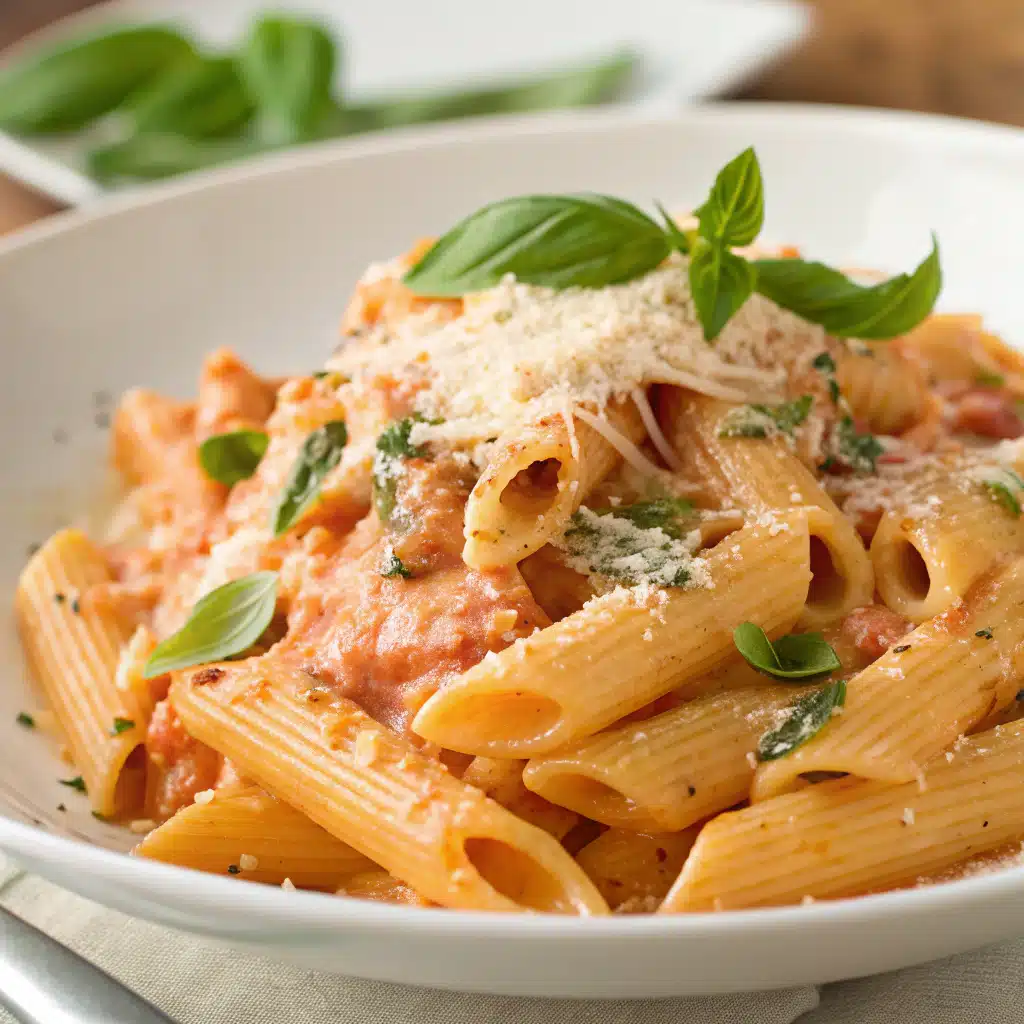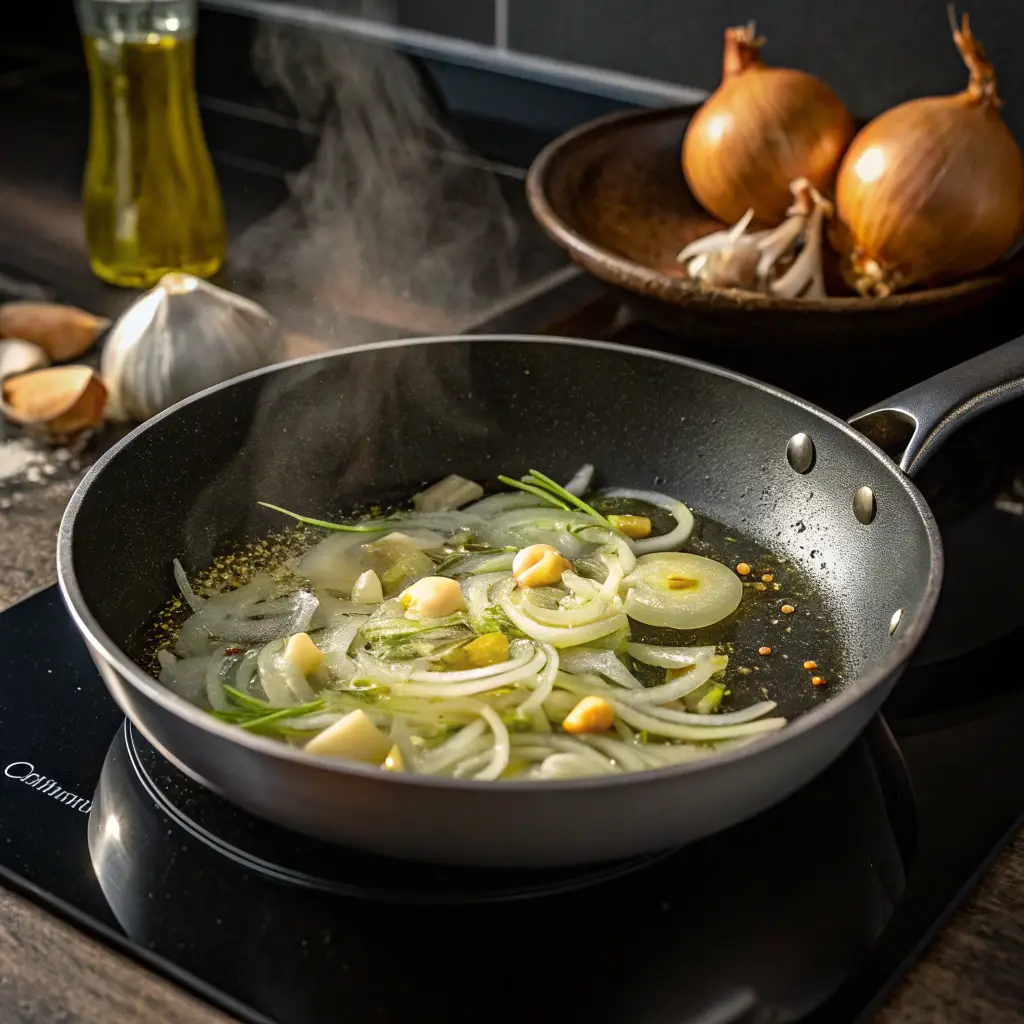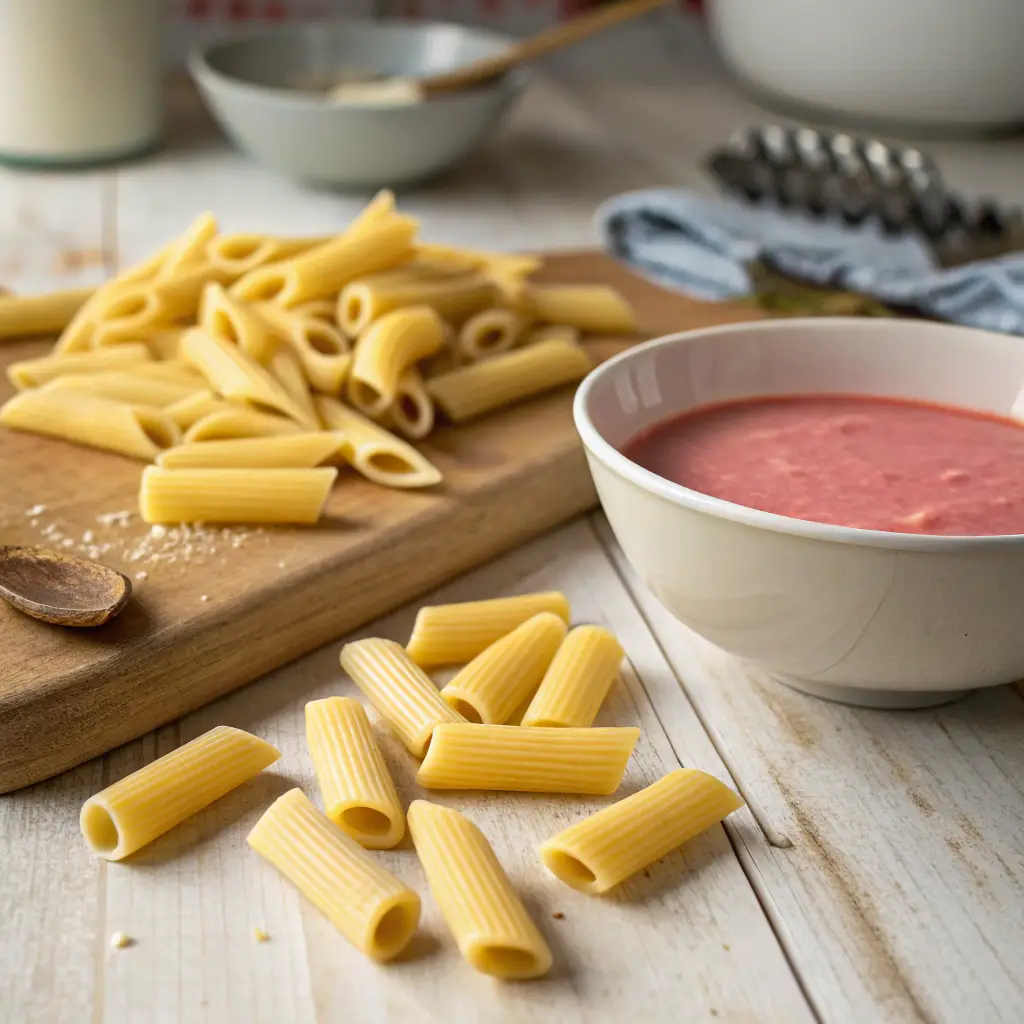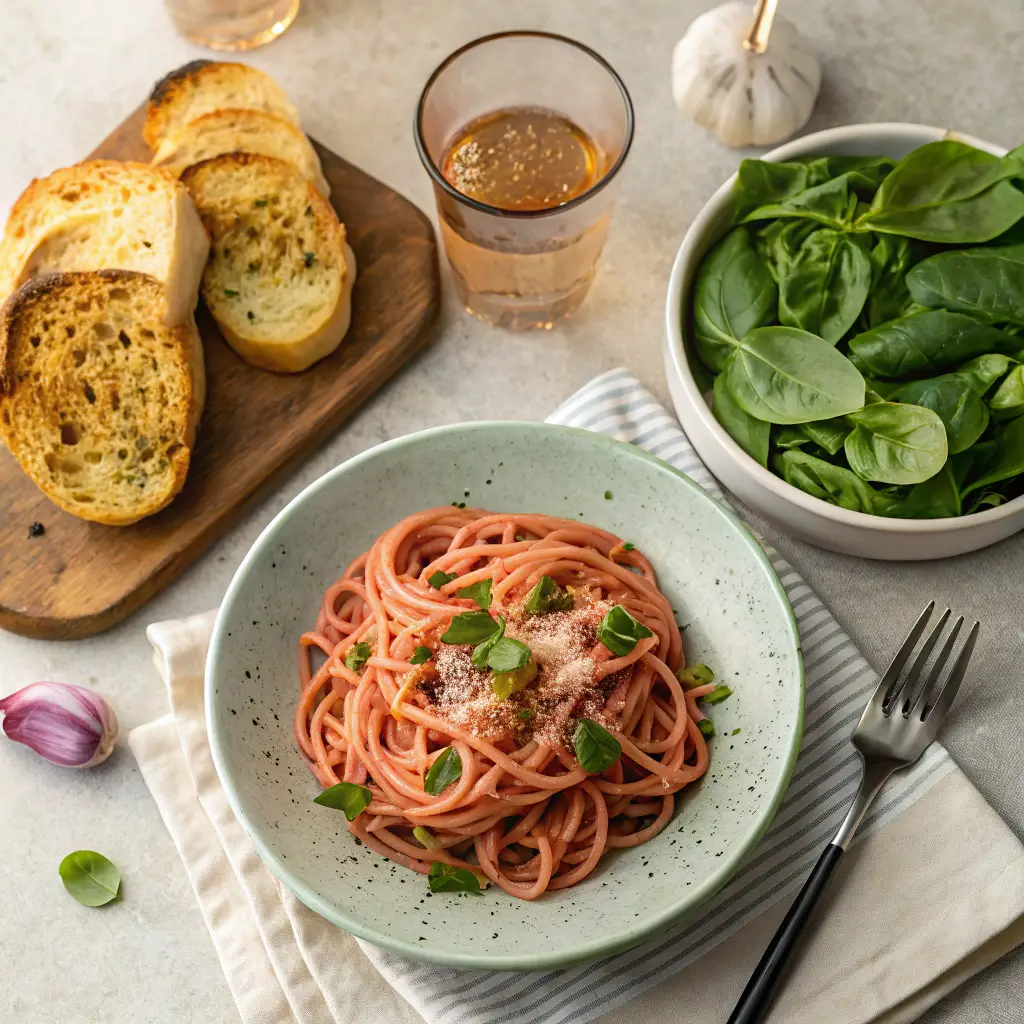Italian pink sauce recipe fans swear by its irresistible blend of creamy richness and tangy tomato flavor. This crowd-pleasing dish takes the boldness of a classic tomato base and smooths it out with velvety cream, creating a gorgeous rosy-hued sauce that clings to pasta like a dream. Whether you’re cooking a romantic dinner, prepping a cozy weeknight meal, or planning a pasta party—this is the sauce you need in your rotation.
In this article, you’ll discover how to master the perfect pink sauce, step-by-step—from choosing the right ingredients and pasta types to cooking techniques, pro tips, and serving suggestions. Along the way, we’ll answer popular questions like what is pink sauce made of, and how to make the best pink sauce pasta at home.
Table of Contents
Table of Contents
PART 1: Understanding Italian Pink Sauce recipe
What Is Italian Pink Sauce?
Italian pink sauce is a creamy tomato-based pasta sauce, known for its delicate pink color. It’s made by combining crushed tomatoes and tomato paste with heavy cream and Parmesan cheese. The result? A savory, tangy, and slightly sweet sauce that wraps around every piece of pasta like a dream.
Often served with penne, rigatoni, or ziti, pink sauce strikes a perfect flavor balance—richer than a marinara, lighter than Alfredo. Though the name might sound trendy, this sauce has deep roots in Italian-American home cooking and trattorias. It’s often nicknamed “rosa sauce” (which means “pink” in Italian) or even referred to casually as tomato cream sauce.
Unlike some trendy “pink sauces” found online with strange ingredients (we’re looking at you, TikTok), this one sticks to Italian culinary tradition—nothing artificial, just bold flavor from real ingredients.
History and Origins of Pink Sauce in Italian Cuisine
While classic Italian sauces like marinara, pesto, or carbonara have centuries of heritage, the pink sauce is more of a modern Italian-American fusion. It likely gained popularity in the mid-20th century as Italian immigrants in the U.S. began to experiment with local ingredients—especially dairy products like cream, which weren’t common in traditional Southern Italian tomato sauces.
This adaptation led to what we now call pink sauce—an American twist on Italian tomato sauces that evolved to please cream-lovers without sacrificing the signature umami-rich base of Italian cooking. Over time, it became a restaurant staple, loved by kids and adults alike.
Though not strictly traditional, its popularity speaks for itself. Italian pink sauce recipe is now found everywhere from home kitchens to upscale restaurants, often served with shrimp, chicken, or simple garden vegetables for an extra dimension.
Ready to start cooking? Let’s get into the ingredient breakdown next.

Italian Pink Sauce Recipe – The Creamiest Pasta Delight You’ll Ever Try
Ingredients
Method
- 1. Bring a large pot of water to a boil. Add pasta and cook according to package directions. Drain, return to the same pot, and set aside.
- 2. In a large skillet over medium heat, add olive oil, onions, garlic, and salt. Sauté for 5 minutes until onions are translucent.
- 3. Add the tomato paste and sauté for 30 seconds to intensify the flavor.
- 4. Add crushed tomatoes, basil, and oregano. Stir and bring to a boil, then lower the heat and simmer for 10 minutes.
- 5. Remove from heat, add grated cheese, and slowly pour in the cream. Stir to combine until sauce is smooth and pink.
- 6. Add 2–3 ladles of sauce to the pasta, stir to coat, and divide into bowls. Serve with extra Parmigiano-Reggiano and a side salad.
Nutrition
Notes
Tried this recipe?
Let us know how it was!PART 2: Key Ingredients in an Authentic Italian Pink Sauce Recipe
Core Ingredients Breakdown (Tomatoes, Cream, Cheese)
At the heart of any great italian pink sauce recipe is the harmony between just a few simple, quality ingredients. Each one plays a role in crafting the sauce’s signature flavor and texture:
- Crushed Tomatoes (28 oz): These form the base of the sauce. Opt for canned crushed San Marzano tomatoes if possible—they’re naturally sweet and low in acidity, providing depth without needing added sugar.
- Tomato Paste (2 tablespoons): Intensifies the tomato flavor, giving the sauce a rich umami body. A quick sauté in olive oil caramelizes it just enough for a roasted finish.
- Heavy Cream (½ cup, 35% fat): The ingredient responsible for that dreamy pink hue. Added at the end, it softens the tanginess of tomatoes and makes the sauce luxuriously smooth.
- Parmigiano-Reggiano Cheese (1.5 oz, finely grated): A sharp and nutty flavor enhancer. It melts into the sauce, creating a savory richness that can’t be duplicated by pre-shredded alternatives.
- Pasta (16 oz penne or ziti): Short-cut pasta works best as it holds the sauce in ridges and curves, delivering more flavor per bite.
These ingredients are common pantry staples, but when combined the right way, they create an elevated, restaurant-quality pasta dish right at home.
Flavor Boosters: Garlic, Basil, and Olive Oil Explained
Great pasta sauce is all about layers of flavor. While the tomatoes and cream form the base, the aromatics and seasonings are what bring the pink sauce to life:
- Extra-Virgin Olive Oil (1 tablespoon): This is the start of everything. Choose a cold-pressed Italian variety for an authentic flavor. It helps bloom the aromatics and gives the sauce a silken mouthfeel.
- Onions (½ cup, diced): Sautéed until translucent, onions add a subtle sweetness that balances the acidity of tomatoes.
- Garlic (2 teaspoons, finely minced): The essential base note. Garlic gives the sauce that irresistible savory aroma that makes your kitchen smell like a trattoria.
- Dried Basil & Oregano (¼ teaspoon each): Herbs provide Italian authenticity. Basil adds freshness, while oregano delivers a slightly peppery, earthy tone.
- Kosher Salt (½ teaspoon): Brings all the flavors together and enhances the overall balance of the sauce.
Pro tip: Always sauté onions and garlic before adding tomatoes. This short step brings out their full flavor and keeps the sauce from tasting flat.
Want to go a step further? Don’t miss our full guide to Italian pantry essentials for more sauce-making tips and tricks.
PART 3: Step-by-Step Guide: How to Make the Best Italian Pink Sauce Recipe Pasta

Cooking the Pasta Perfectly Every Time
The foundation of a delicious italian pink sauce recipe is perfectly cooked pasta. Just follow these simple steps to nail it!
- Boil a Large Pot of Water – Use about 4 to 6 quarts of water for 16 ounces of pasta. Add a generous tablespoon of kosher salt to flavor the pasta while it cooks.
- Cook the Pasta Until Al Dente – Penne or ziti works best for pink sauce. Check the package instructions and cook until the pasta is tender but still firm when bitten.
- Reserve a Cup of Pasta Water – Before draining, save some pasta water. This starchy liquid is liquid gold—it helps loosen up the sauce and binds it to the pasta.
- Drain and Set Aside – After draining, return the pasta to the pot. Do not rinse it—this removes the starch that helps the sauce cling to it.
Want to level up your pasta texture? Check out our complete pasta-cooking cheat sheet to avoid common mistakes.
Sautéing and Building the Sauce Layers
Now for the magic—the rich, creamy pink sauce.
- Sauté Aromatics:
In a large skillet over medium heat, heat 1 tablespoon of extra-virgin olive oil. Add ½ cup diced onion, 2 teaspoons finely minced garlic, and ½ teaspoon kosher salt. Sauté for 5 minutes, until onions become translucent and fragrant. - Add Tomato Paste:
Stir in 2 tablespoons of tomato paste. Cook for 30 seconds to a minute until it darkens slightly and smells caramelized. This step builds a deep tomato flavor. - Pour in Crushed Tomatoes:
Add a 28-ounce can of crushed tomatoes along with ¼ teaspoon dried basil and ¼ teaspoon oregano. Stir everything together and bring it to a gentle boil. - Simmer Gently:
Lower the heat and simmer for about 10 minutes, keeping the lid slightly ajar. This lets excess water evaporate, concentrating the flavor and thickening the sauce. - Stir in Cheese and Cream:
Turn off the heat. Add 1.5 ounces of finely grated Parmigiano-Reggiano. Slowly pour in ½ cup heavy cream while stirring to blend it all together. The sauce should now have a silky texture and a soft pink-orange hue. - Combine with Pasta:
Spoon 2 to 3 ladles of sauce over the cooked pasta and toss to coat thoroughly. Add more sauce depending on how saucy you like it. You can also mix in a splash of reserved pasta water if needed for a smoother consistency. - Garnish and Serve:
Top with extra Parmigiano-Reggiano and serve with a spinach or arugula salad for a complete Italian-inspired meal.
PART 4: Expert Tips for Making the Creamiest Pink Sauce
Mistakes to Avoid While Making Pink Sauce
Even a simple italian pink sauce recipe can go sideways without the right technique. Here are the most common mistakes—and how to avoid them:
- Adding Cream Too Early: Cream should always be added after removing the sauce from heat. High heat can cause it to curdle or separate, giving you a grainy sauce instead of that smooth, glossy finish.
- Using Low-Quality Cheese: Parmigiano-Reggiano isn’t just tradition—it’s essential for flavor. Skip the powdered or pre-shredded stuff, which often contains anti-caking agents that affect melting.
- Overcooking the Garlic: Burnt garlic turns bitter fast. Sauté just until fragrant (about 30–60 seconds). Watch closely and stir constantly.
- Skipping the Simmer: Simmering your tomatoes for at least 10 minutes lets flavors meld and thickens the sauce naturally. Rushing this step leaves your sauce watery and underdeveloped.
- Not Tasting Before Serving: Always taste your sauce before combining it with pasta. Adjust salt or add a pinch of sugar if needed to balance acidity.
These simple tips can be the difference between a flat, forgettable meal and a restaurant-quality pasta experience.
Texture Tips: How to Avoid Curled or Separated Sauce
Creamy sauces demand balance. To get that dreamy consistency, use these pro kitchen tricks:
- Use Full-Fat Cream (35%+): Lower-fat cream may split when combined with acidic tomatoes. Heavy cream is more stable and yields the silkiness you want.
- Let the Sauce Cool Slightly Before Adding Cream: A temperature drop of even 20–30 seconds makes a huge difference. Pouring cold cream into boiling sauce? Not a good idea.
- Whisk Constantly: Stirring slowly and continuously while adding cream helps emulsify the fat into the tomato base for a smooth blend.
- Thin with Pasta Water as Needed: If your sauce feels too thick or sticky, stir in a tablespoon or two of reserved starchy water. It’ll loosen the texture without diluting the flavor.
Pro Tip: Want to take it next level? Use an immersion blender for 10 seconds after the sauce is finished—it’ll give you that velvety finish most restaurant sauces have.
Looking for inspiration? Try our creamy pasta troubleshooting guide to fix any sauce hiccups in real time.
PART 5: Best Pasta Pairings with Italian Pink Sauce recipe

Short-Cut Pasta Types That Work Best (Penne, Ziti, etc.)
When it comes to pairing pasta with a luscious sauce like the one in our italian pink sauce recipe, not all shapes are created equal. You want something that holds onto the sauce—not lets it slide off.
Here are the top pasta shapes to try:
| Pasta Type | Why It Works |
|---|---|
| Penne Rigate | Ridged surface and tube shape capture every drop of creamy pink sauce |
| Ziti | Slightly smoother than penne but still excellent for thick sauces |
| Rotini | Spirals scoop up the sauce into every twist |
| Rigatoni | Larger tubes with ridges add a bold, satisfying bite |
| Fusilli | Curly shape wraps the sauce like a ribbon |
Avoid thin pastas like angel hair or spaghetti—they’re better suited for light oil- or broth-based sauces and won’t cling to the richness of pink sauce as well.
Pro tip: Slightly undercook the pasta by 1 minute and finish it in the sauce. This lets the pasta absorb flavor and improves the sauce-pasta bond.
Gluten-Free and Whole-Wheat Options for Healthier Eating
Whether you’re cutting gluten or looking for more fiber, there are solid alternatives that still play well with this creamy pink sauce.
- Gluten-Free Pasta: Choose corn, rice, or quinoa-based short-cut pasta. Cook carefully to avoid mushy textures. Brown rice penne is one of the best for holding sauce.
- Whole-Wheat Pasta: Has a firmer bite and more earthy flavor. It can balance nicely with the creamy tang of the pink sauce, though it may absorb sauce faster—so be generous when serving.
- Legume-Based Pasta (Lentil, Chickpea): High in protein and perfect for a meatless dinner. Their nutty taste works well with the cheese and tomato elements of the sauce.
Whatever your pasta preference, the key is to choose a shape and texture that enhances—not competes with—the creamy complexity of the sauce.
Discover great ideas like our pasta shape and sauce compatibility guide to make every bite count.
PART 6: Customizing Your Italian Pink Sauce Recipe
Add-Ins: Chicken, Shrimp, or Roasted Veggies
One of the best things about an italian pink sauce recipe is how adaptable it is. Whether you’re a meat-lover, seafood fan, or a veggie-first eater, you can easily customize it without compromising flavor.
Protein Upgrades:
| Add-In | How to Use It |
|---|---|
| Grilled Chicken | Slice cooked chicken breast and stir into the sauce before serving |
| Sautéed Shrimp | Cook shrimp with garlic and olive oil, then fold into the pink sauce |
| Italian Sausage | Brown and drain sausage before adding it into the simmering sauce for extra richness |
Vegetable Boosts:
| Veggie Option | Flavor Benefit |
|---|---|
| Roasted Zucchini or Eggplant | Adds depth and a slightly smoky note |
| Spinach or Arugula | Toss in fresh greens right at the end—they wilt beautifully in the warm sauce |
| Sautéed Mushrooms | Their umami pairs wonderfully with the creamy-tomato blend |
Looking for inspiration? Try our guide to flavor-pairing proteins and veggies with Italian sauces for even more ideas.
Making It Spicy or Dairy-Free: Simple Substitutes
Want to give your pink sauce some heat—or make it friendly for dairy-free eaters? No problem.
Turn Up the Heat:
- Add ¼ teaspoon red pepper flakes during the garlic sauté step.
- Stir in a touch of Calabrian chili paste or a splash of hot sauce if you’re feeling bold.
Go Dairy-Free Without Losing Creaminess:
| Ingredient | Substitute |
|---|---|
| Heavy Cream | Use full-fat coconut cream or unsweetened oat cream for a neutral flavor |
| Parmesan Cheese | Swap with nutritional yeast or a vegan Parmesan-style alternative |
These changes keep the sauce smooth and full of flavor—just with a plant-based twist.
Don’t miss our dairy-free creamy pasta sauces collection to explore even more ways to reinvent this classic
PART 7: Side Dishes and Serving Ideas

Best Salads to Serve with Pink Sauce Pasta
A creamy, comforting italian pink sauce recipe pairs beautifully with crisp, fresh salads that cut through the richness. These simple sides enhance the meal without stealing the spotlight.
Top Salad Pairings:
| Salad | Why It Works |
|---|---|
| Spinach & Arugula Salad | The peppery bite of arugula and earthy spinach contrast the creamy sauce |
| Caprese Salad | Tomato and mozzarella echo flavors in the pasta while basil adds freshness |
| Simple Mixed Greens | A lemony vinaigrette balances the dish with brightness and acidity |
| Kale Caesar | Hearty enough to stand up to a rich sauce, especially when topped with shaved Parmesan |
Pro tip: Toss salads with vinaigrettes, not creamy dressings—let the pasta take center stage with its own creamy character.
Check out our list of Italian salad recipes to find the perfect complement for your next pasta night.
soda Pairings and Bread Options for a Full Italian Meal
When it comes to building a full Italian-inspired experience around your italian pink sauce recipe, don’t stop at salad. Choose a soda and some fresh bread to take it to the next level.
Bread on the Side:
- Garlic Bread: A classic choice—crispy edges and buttery garlic spread are unbeatable.
- Focaccia: Dippable and flavorful, especially with herbs and sea salt.
- Rustic Baguette: Perfect for soaking up every last bit of that silky sauce.
Whether you’re preparing a casual weeknight dinner or hosting guests, adding a simple salad, a crusty loaf of bread, and a glass of soda turns a plate of pasta into a full Italian meal.
PART 8: Storage and Reheating for Italian Pink Sauce Recipe
How to Store Pink Sauce Properly
You’ve followed every step of the italian pink sauce recipe, and now you’ve got leftovers. Good news: this sauce keeps well—if you store it correctly.
Here’s how to store pink sauce the right way:
- Cool Before Storing: Let the sauce cool to room temperature. Placing hot sauce in a sealed container traps steam and causes separation.
- Use Airtight Containers: Transfer sauce (or pasta with sauce) into an airtight glass or BPA-free plastic container.
- Refrigeration: Store in the fridge for up to 4 days. The flavor actually deepens over time, making it even better the next day.
- Freezing: You can freeze pink sauce without the pasta for up to 2 months. Use freezer-safe containers and leave space for expansion.
Label your container with the date and contents to avoid freezer surprises later.
Check out our guide to freezing Italian sauces without losing flavor for more pro storage hacks.
Reheating Without Losing Creaminess
Reheating pink sauce isn’t hard—but doing it wrong can turn it from velvety to grainy. Here’s how to keep it smooth:
If You Stored the Sauce Separately:
- Warm it in a saucepan over low heat, stirring constantly.
- Add a splash of cream or milk to refresh its creamy texture.
- Whisk gently while reheating—don’t let it boil.
If You Stored Sauce and Pasta Together:
- Reheat in a skillet with 2 tablespoons of water or milk over medium-low heat.
- Cover with a lid to trap moisture and avoid drying out.
- Stir every minute or so until hot and evenly coated.
Microwave Method (Quick Fix):
Add a dash of milk or reserved pasta water if the sauce thickens too much.
Place in a microwave-safe bowl.
Cover loosely and heat in 30-second bursts, stirring between each.
PART 9: Nutritional Value and Caloric Breakdown
Nutritional Information of Classic Pink Sauce Pasta recipe
Understanding what goes into your italian pink sauce recipe helps you enjoy it more mindfully. While this dish is indulgent, it doesn’t have to be a nutritional mystery.
Here’s an approximate breakdown per serving (based on 6 servings from the full recipe):
| Nutrient | Amount per Serving |
|---|---|
| Calories | 510 kcal |
| Total Fat | 23g |
| Saturated Fat | 12g |
| Carbohydrates | 58g |
| Sugars | 6g |
| Protein | 15g |
| Fiber | 4g |
| Sodium | 580mg |
| Cholesterol | 60mg |
These numbers will vary depending on the type of pasta you use and whether you include optional toppings like extra cheese or protein.
While the fat and calorie content come mainly from the cream and cheese, the protein and fiber can be boosted with whole-wheat pasta or veggie add-ins.
Tips for Reducing Calories Without Sacrificing Taste
If you’re watching calories but still want that creamy pink goodness, don’t worry—you can tweak your italian pink sauce recipe without sacrificing flavor.
Simple Slim-Down Options:
- Use Light Cream or Half-and-Half instead of heavy cream (reduce fat by up to 40%)
- Cut Down on Cheese or use a hard-aged cheese like Pecorino Romano, which packs more punch in smaller amounts
- Bulk It Up with Veggies like zucchini, spinach, or mushrooms for volume without extra calories
- Serve with Chickpea Pasta or lentil-based pasta for more protein and fiber per bite
These swaps still preserve the essence of the dish while making it a little lighter on the waistline.
Don’t miss our healthy Italian pasta swap chart for more smart ingredient alternatives.
FAQs About Italian Pink Sauce Recipe
What is Italian pink sauce made of?
Italian pink sauce is made by combining a tomato-based sauce with heavy cream, resulting in a creamy, rosy-colored pasta sauce. The core ingredients include crushed tomatoes, tomato paste, garlic, onions, olive oil, dried herbs like basil and oregano, heavy cream, and grated Parmigiano-Reggiano cheese. This fusion creates a balance of tangy tomato flavor and rich, velvety creaminess.
What are the ingredients of pink sauce?
A traditional pink sauce recipe includes:
Crushed tomatoes
Tomato paste
Garlic and onions
Olive oil
Kosher salt and Italian herbs
Parmigiano-Reggiano cheese
Heavy cooking cream
Optionally, you can add grilled chicken, shrimp, or vegetables for extra protein and texture.
How to make the best pink sauce pasta?
To make the best pink sauce pasta:
Cook short-cut pasta like penne until al dente.
In a skillet, sauté onions and garlic in olive oil.
Add tomato paste and crushed tomatoes with herbs and simmer.
Stir in Parmigiano-Reggiano cheese and heavy cream off heat.
Toss the sauce with pasta, garnish with extra cheese, and serve warm.
For best results, use full-fat cream and freshly grated cheese, and simmer the sauce gently to avoid curdling.
What is the real name for pink sauce pasta?
While widely known as pink sauce pasta, the dish may also be referred to as:
Penne alla Rosa
Tomato Cream Sauce Pasta
Rosa Sauce Pasta
These names describe the same creamy tomato-based pasta dish, which is a popular comfort food both in Italian-American households and restaurants.
Conclusion
If you’re craving a creamy, tangy, comforting pasta dish, this italian pink sauce recipe is the perfect answer. With its velvety blend of crushed tomatoes, cream, garlic, and Parmigiano-Reggiano, it’s a timeless favorite that never fails to impress. Whether you stick to the classic or customize it with chicken, shrimp, or roasted veggies, it adapts beautifully to your kitchen style.
From ingredient tips to storage hacks, this guide equips you to create the best homemade pink sauce pasta—and even elevate it into a restaurant-worthy meal. Serve it with a crisp salad, warm focaccia, and your favorite soda for a full Italian experience.
Looking for more pasta inspiration? Check out our creamy sauce collection and don’t miss our vegetarian Italian dinner ideas to round out your meal planning.
Want more recipe inspiration and daily kitchen tips?
Follow us on Facebook at Save All Recipes and get delicious updates right in your feed.
